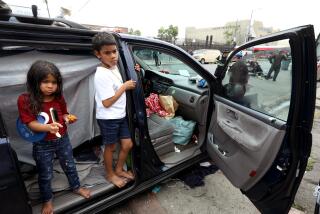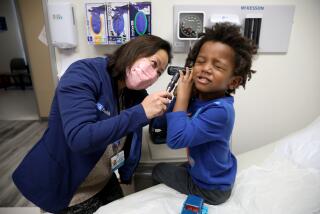A School Clinic for ‘Third World’ Ills : * Pilot Program in Santa Ana Will Dispense Badly Needed Care, Not Sex Education
- Share via
A physician examining a group of youngsters recently remarked that he felt as if he was practicing Third World medicine. But he wasn’t. He was right here in Orange County, examining young schoolchildren in Santa Ana.
What disturbed the doctor, and should disturb many other people, is that aside from the locale, little was different from the Third World. Most of the youngsters were ill in some way--and most had never seen a doctor regularly. Some, except for the legally required shots for school, had never seen a doctor at all.
It does not take a medical degree to know that when you are ill and not feeling well, your performance level drops, sometimes drastically. When that happens, most people seek medical help. But for too many of the youngsters the physicians examined, that is a luxury their families simply cannot afford. Their parents have no money for medical care. And no insurance. So the children just do without.
The physicians found that 88% of the children they examined had physical problems needing follow-up treatment. The ills they discovered ranged from infections to a heart murmur.
Shocking? Yes. But not surprising. That was precisely what the doctors, educators and others representing Santa Ana 2000, Children’s Hospital of Orange County and the local chapter of the American Academy of Pediatrics--who arranged the exams--suspected that they would find.
The solution being studied is a pilot health program, in which a clinic would be set up at one elementary school in the Santa Ana Unified School District. At that school, youngsters 5 to 11 years old with parental consent would receive health care--at no cost to them or to the school district.
Contrary to what some critics fear, medical care and preventive medicine is all that health proponents wish to dispense--not contraceptives or sex education. The proponents know of the national studies that have linked health problems with unnecessary learning difficulties for children.
Still to be decided in Santa Ana is not only how to pay for the health program, but even whether to create it. The idea may be rejected.
But if it is, what about the nagging problem that would remain? That is, what should be done about the thousands of youngsters who, we now know for sure, are doing without needed medical care--and, medically and scholastically, are silently suffering the consequences of that neglect?
More to Read
Sign up for Essential California
The most important California stories and recommendations in your inbox every morning.
You may occasionally receive promotional content from the Los Angeles Times.













